Biographical Information

URL: www.ldeo.columbia.edu/vetlesen/recipients/1962/jeffries_bio.html
Sir Harold Jeffreys was born in Fatfield, Washington, County Durham, England on April 22, 1891. His work mainly focused in astronomy, geophysics and mathematics. He began his collegiate career as a student at the University of Durham. He then moved on to St. Johns college and Cambridge University for his masters work. Jeffreys taught mathematics, geophysics and became the Plumian Professor of Astronomy at Cambridge University. From 1939 to 1952, he was the Director of the International Seismology Summary and retired in 1958. Sir Harold Jeffreys died in Fatfield on March 18, 1989.
Specific contributions to plate tectonic theory
Jeffreys was actually an opponent to Wegener's theory of continental drift. His main issue with the theory was Wegener's idea about how the continents moved. Wegener stated that the continents simply plowed through the oceanic crust when they moved. Jeffreys calculated that the Earth is simply too rigid for that to have happened. According to Jeffreys calculations that if the Earth was weak enough for plates to move through the oceanic crust then mountains would crumble under their own weight. Wegener also stated that the continents moved in a westward direction due to tidal forces affecting the interior of the planet. Again, Jeffreys calculations show that tidal forces that strong would stop the rotation of the Earth within a year. Basically, according to Jeffreys, the Earth is simply too rigid to allow for any significant movement of the crust.
Other interesting scientific contributions
Jeffreys had many contributions to other areas of science. He determined that the Earth's core is composed of a large quantity of rocks and metals in a liquid state. He determined this by working with earthquake data and developed many tables of seismic wave travel times that are still used today to determine epicenter locations and depths.
He also did a significant amount of work in astronomy as well. Jeffreys calculated the temperatures of the Jovian planets and determined them to be nearly 100 degrees Celcius cooler than what previously thought. He also did significant work with fluid dynamics and the internal structure of the Earth and other terrestrial planets. Most of his work used mathematics to answer questions that most scientist thought to be mainly qualitative.

URL: www.hollowplanets.com/journal/images/art004c.jpg
Other cool stuff you should know
Sir Harold Jeffreys also won a number of awards throughout his lifetime:
- 1937 - Gold Medal of the Royal Astronomical Society
- 1948 - Prix Charles Lagrange from Academie royale des Sciences
- 1953 - Knighted for outstanding discoveries in science and mathematics
- 1960 - Copely Medal
- 1962 - Royal Statistical Society's Guy Medal in Gold
Lady Jeffreys was also a mathematics professor and many of Sir Harold's 300 papers in science and mathematics were written with her. He has also written seven books, the most famous being The Earth: Its Origin, History and Physical Constitution which has been revised through six editions.

URL: www.infibeam.com
Another area that Jeffreys did a vast amount of work was in the area of Bayesian probability. Bayesian probability (named after the 18th Century mathematician Thomas Bayes) allows the user to reason the answer to a problem using unceratin data. After setting up the initial formula the researcher can update it at a later time when new, more relevant data becomes available. It describes probability as, "a measure of a state of knowledge" not simply as a measure of how frequently a certain act will occur in the system.
Bibliography
1. Hallam, A. (1975). Alfred wegener and the hypothesis of continental drift. Scientific American, 232 (2), 88-97.
2. Jeffreys, H. (1976). The earth: its origin, history and physical constitution. Cambridge, United Kingdom: Cambridge University Press.
3. Spall, H. (1980). Sir harold jeffreys: an interview. Earthquake Information Bulletin, 12(2), 3.
4. Bowler, P. (2000). The earth encompassed. New York, New York: W. W. Norton and Company.
5. Lewis, C. (2000). The dating game: one mans search for the age of the earth. Cambridge, United Kingdom: Cambridge University Press.
6. Oreskes, N. (2001). Plate tectonics: an insiders guide to the modern theory of the earth. Boulder, Colorado: Westview Press.